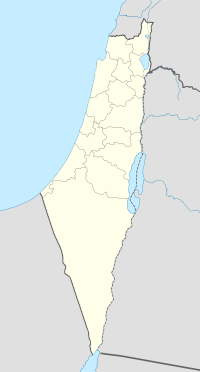Al-Nabi Rubin, Ramla
| al-Nabi Rubin | |
|---|---|

The shrine of Nabi Rubin in 2009
|
|
| Arabic | النبي روبين |
| Name meaning | "The Prophet Reuben" |
| Also spelled | al-Nebi Rubin |
| Subdistrict | Ramle |
| Coordinates | 31°55′46″N 34°44′02″E / 31.92944°N 34.73389°ECoordinates: 31°55′46″N 34°44′02″E / 31.92944°N 34.73389°E |
| Palestine grid | 124/148 |
| Population | 1,420 (1945) |
| Area | 31,002 dunams 31.0 km² |
| Date of depopulation | June 1, 1948 |
| Cause(s) of depopulation | Expulsion by Yishuv forces |
| Current localities | Palmachim,Gan Sorek |
Al-Nabi Rubin (Arabic: النبي روبين, transliteation: an-Nabî Rûbîn) was a Palestinian village in central Palestine, located 14.5 kilometers (9.0 mi) west of Ramla, just northeast of Yibna and 18 kilometers (11 mi) south of Jaffa. The village was situated on the southern banks of Wadi al-Sarar, known in Hebrew as Sorek Stream, at an elevation of 25 meters (82 ft) above sea level. Nabi Rubin is named after a shrine in the village, believed by Muslims to be the tomb of Reuben. It was captured by the Israel Defense Forces during the 1948 Arab-Israeli War, and the inhabitants were expelled.
Walid Khalidi writes that it is believed that the shrine for al-Nabi Rubin was built in the same place where a Canaanite temple had once stood, and that the mawsim ("religious festival") itself was pagan in origin.
Nabi Rubin was a place of trade between Crusaders and Muslims prior to it being inhabited. In 1184, it held a fair where Arab merchants from Damascus traded slaves, Persian and Kurdish-bred horses, weapons, and blades from Yemen and India, with Christians from Acre. This trade continued until wars between the Mamluks and Crusaders commenced in the 13th century.
The Nabi Rubin mawsim was one of two prominent mawsims for Old Testament prophets in Palestine—the other being dedicated to Nabi Musa ("the prophet Moses") near Jericho.
...
Wikipedia

